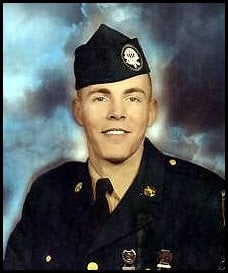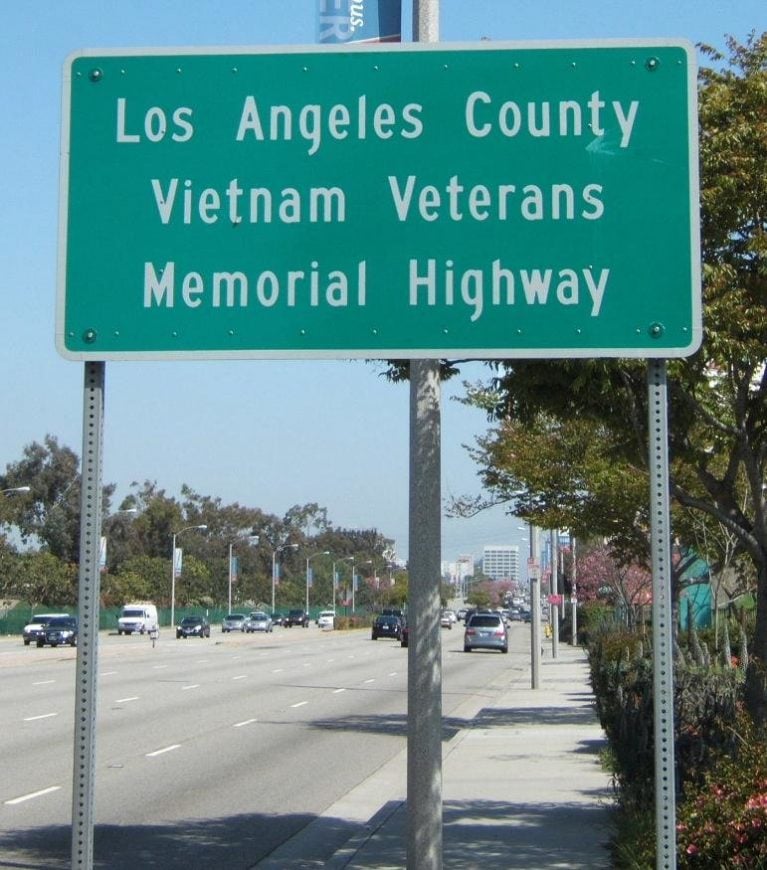HONORED ON PANEL 55E, LINE 26 OF THE WALL
LLOYD FRANCIS MOUSSEAU
WALL NAME
LLOYD F MOUSSEAU
PANEL / LINE
55E/26
DATE OF BIRTH
CASUALTY PROVINCE
DATE OF CASUALTY
HOME OF RECORD
COUNTY OF RECORD
STATE
BRANCH OF SERVICE
RANK
REMEMBRANCES
LEFT FOR LLOYD FRANCIS MOUSSEAU
POSTED ON 11.19.2010
Photo
POSTED ON 5.26.2010
POSTED BY: Robert Sage
We Remember
Lloyd is buried at All Souls Cemetery in Long Beach, CA. DSC SS SM BSM PH
read more
read less
POSTED ON 4.21.2010
Los Angeles County Vietnam Veterans Memorial Highway
A portion of Sepulveda Boulevard/State Highway Route 1 in El Segundo near Los Angeles International Airport has been dedicated to the residents of Los Angeles County who served in Vietnam. This section of highway is now designated the Los Angeles County Vietnam Veterans Memorial Highway. Adopted by the California State Legislature in 2000, the highway honors the more than 350,000 California veterans who served in the Vietnam War, including the 5,822 killed or missing in action. Los Angeles County has the largest number of Vietnam veterans in California and 1,857 of its residents were killed or missing in action during that war. This memorial corridor provides a fitting and proper way for the residents of Los Angeles County to express their gratitude and appreciation for the sacrifices these Vietnam veterans have made for their country.
read more
read less
POSTED ON 12.17.2008
POSTED BY: Tom Mealy-Pilot 189th AHC 1967
An Honor
It was an honor to fly you and the team. the picture of you and the team stays in my bible and my family know of you. You will never be forgotten. You truly are a Hero in my eyes.
read more
read less
POSTED ON 10.31.2007
POSTED BY: CLAY MARSTON
IN REMEMBRANCE OF THIS MOST HEROIC UNITED STATES ARMY SOLDIER WHOSE NAME SHALL LIVE FOREVER MORE
STAFF SERGEANT
LLOYD FRANCIS MOUSSEAU
COMMAND AND CONTROL ( SOUTH )
DETACHMENT B-56
5th SPECIAL FORCES GROUP ( AIRBORNE )
1st SPECIAL FORCES
CITATION FOR POSTHUMOUS AWARD OF
THE DISTINGUISHED SERVICE CROSS
The Distinguished Service Cross is presented to Lloyd Francis Mousseau, Staff Sergeant, United States Army, for extraordinary heroism in connection with military operations involving conflict with an armed hostile force in the Republic of Vietnam, while serving with Detachment B-56, 5th Special Forces Group (Airborne), 1st Special Forces. Staff Sergeant Mousseau distinguished himself by exceptionally valorous actions on 2 May 1968 as assistant team leader of a twelve-man Special Forces/Vietnamese reconnaissance patrol operating in enemy territory. The patrol was heavily attacked by enemy forces firing grenades, small arms and automatic weapons. Although Sergeant Mousseau was seriously wounded in the initial barrage, he ignored his injuries and braved the devastating fire time after time to deploy his men in a tight defensive perimeter. While fighting furiously to repel the determined attackers, a cartridge ruptured in his rifle, wounding him again and rendering the weapon inoperative. He quickly secured another rifle from a fallen comrade in time to engage and kill three enemy troops who had reached his defensive lines. The patrol leader was killed and Sergeant Mousseau immediately assumed command. Using a radio, he directed gunship strikes on the insurgents which forced them back. As an extraction helicopter attempted to land, it was hit by a renewed enemy fusillade and crashed. Sergeant Mousseau continued to direct close air support. Despite grenade wounds to his legs, he maneuvered under a curtain of fire to locate enemy positions and strong points. He then adjusted napalm and bombs to within thirty meters of his perimeter, forcing the enemy to withdraw. When a rescue helicopter arrived, he directed his men aboard before mounting the craft himself. As he entered the ship, he was killed by an enemy sniper. His fearless and selfless leadership in the heat of battle prevented his unit from being overrun. Staff Sergeant Mousseau's extraordinary heroism and devotion to duty were in keeping with the highest traditions of the military service and reflect great credit upon himself, his unit, and the United States Army.
DE OPPRESSO LIBER
THE PROUD YOUNG VALOR THAT ROSE ABOVE THE MORTAL
AND THEN, AT LAST, WAS MORTAL AFTER ALL
YOU ARE NOT FORGOTTEN
NOR SHALL YOU EVER BE
************************************************************
ARMY MEDAL OF HONOR CITATION TO
MASTER SERGEANT ROY P. BENAVIDEZ
WHO WAS THE FOCAL POINT OF THE
RESCUE OPERATION ON THAT FATEFUL DAY
ROY P. BENAVIDEZ
Master Sergeant, then Staff Sergeant, United States Army. Who distinguished himself by a series of daring and extremely glorious actions on 2 May 1968 while assigned to Detachment B-56, 5th Special Forces Group (Airborne). 1st Special Forces, Republic of Vietnam. On the morning of 2 May 1968, a 12-man Special Forces Reconnaissance Team was inserted by helicopters in a dense jungle area west of Loc Ninh, Vietnam to gather intelligence information about confirmed large-scale enemy activity. This area was controlled and routinely patrolled by the North Vietnamese Army. After a short period of time on the ground, the team met heavy enemy resistance and requested emergency extraction. 3 helicopters attempted extraction, but were unable to land due to intense enemy small arms and anti-aircraft fire. Sergeant Benavidez was at the Forward Operating Base in Loc Ninh monitoring the operation by radio when these helicopters returned to off-load wounded crew members and to assess aircraft damage. Sergeant Benavidez voluntarily boarded a returning aircraft to assist in another extraction attempt. Realizing that all the team members were either dead or wounded and unable to move to the pickup zone, he directed the aircraft to a nearby clearing where he jumped from the hovering helicopter, and ran approximately 75 meters under withering small arms fire to the crippled team. Prior to reaching the team's position he was wounded in his right leg, face and head. Despite these painful injuries he took charge, repositioning the team members and directing their fire to facilitate the landing of an extraction aircraft, and the loading of wounded and dead team members. He then threw smoke canisters to direct the aircraft to the team's position. Despite his severe wounds and under intense enemy fire, he carried and dragged half of the wounded team members to the awaiting aircraft. He then provided protective fire by running alongside the aircraft as it moved to pick up the remaining team members. As the enemy's fire intensified, he hurried to recover the body and classified documents on the dead team leader. When he reached the leader's body, Sergeant Benavidez was severely wounded by small arms fire in the abdomen and grenade fragments in his back. At nearly the same moment, the aircraft pilot was mortally wounded, and his helicopter crashed. Although in extremely critical condition due to his multiple wounds, Sergeant Benavidez secured the classified documents and made his way back to the wreckage, where he aided the wounded out of the overturned aircraft, and gathered the stunned survivors into a defensive perimeter. Under increasing enemy automatic weapons and grenade fire, he moved around the perimeter distributing water and ammunition to his weary men, re-instilling in them a will to live and fight. Facing a buildup of enemy opposition with a beleaguered team, Sergeant Benavidez mustered his strength, began calling in tactical air strikes and directed the fire from supporting gun ships to suppress the enemy's fire and so permit another extraction attempt. He was wounded again in his thigh by small arms fire while administering first aid to a wounded team member just before another extraction helicopter was able to land. His indomitable spirit kept him going as he began to ferry his comrades to the craft. On his second trip with the wounded, he was clubbed with additional wounds to his head and arms before killing his adversary. He then continued under devastating fire to carry the wounded to the helicopter. Upon reaching the aircraft, he spotted and killed 2 enemy soldiers who were rushing the craft from an angle that prevented the aircraft door gunner from firing upon them. With little strength remaining, he made one last trip to the perimeter to ensure that all classified material had been collected or destroyed, and to bring in the remaining wounded. Only then, in extremely serious condition from numerous wounds and loss of blood, did he allow himself to be pulled into the extraction aircraft. Sergeant Benavidez' gallant choice to voluntarily join his comrades who were in critical straits, to expose himself constantly to withering enemy fire, and his refusal to be stopped despite numerous severe wounds, saved the lives of at least 8 men. His fearless personal leadership, tenacious devotion to duty, and extremely valorous actions in the face of overwhelming odds were in keeping with the highest traditions of the military service, and reflect the utmost credit on him and the United States Army.
read more
read less



